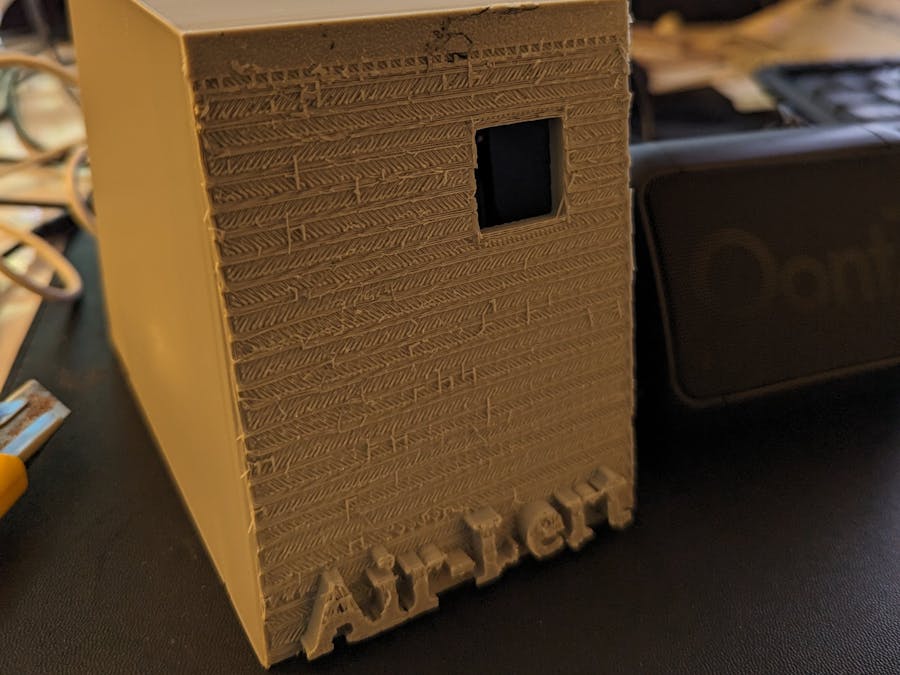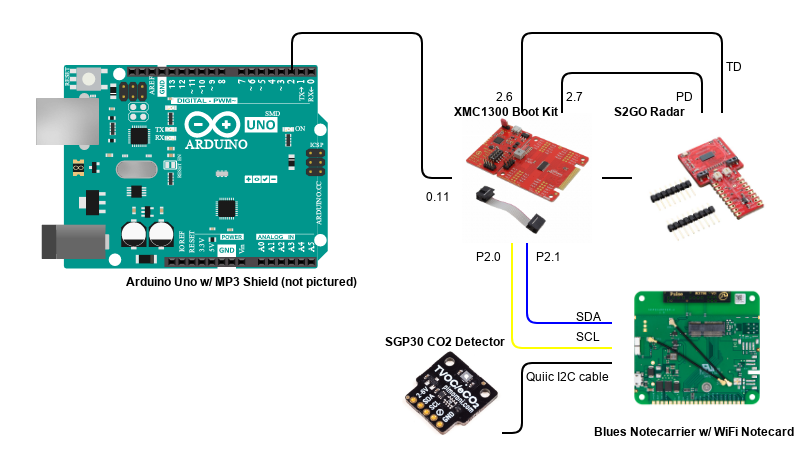In the United States, work injuries resulted over $167 billion in costs in the year 2021. Until robots are able to be universally implemented in factories (in the author's opinion, still decades away), humans will have to continue to work in dangerous conditions that risk injury to their body and health.
This project, what I call Air-Lert, utilizes hardware from Infineon, Arduino, Blues, Pimoroni, and Adafruit. Air-Lert mitigates the health risk to humans by creating a series of alerts to notify workers (and their supervisors) of unsafe environmental conditions.
Air-Lert is straight-forward: it uses a radar sensor to detect if someone is in the room. It also has an environmental sensor to detect unsafe environmental conditions in the room. For the sake of testing (and not jeopardizing my health!) I used to a carbon dioxide sensor to detect elevated levels of carbon dioxide (CO2) in the room. But any sensor to detect any range of unsafe conditions (chemical, temperature, for example) could be used. If a person is detected in the room and elevated CO2 levels are detected, two alerts are generated. The first is an audio alert to alert the person that unsafe conditions are detected. This audio alert will continue as long as the elevated levels exceed the threshold. The second alert is a text message that is sent to the lab supervisor, indicating that unsafe conditions are present in the room, and to evacuate personnel.
It is important to have both the radar sensor and the environmental sensor, as there may be scenarios where those elevated levels are required as part of production, as long as people aren't present in the room. You wouldn't want the alarm to go off as part of normal production, but rather only if someone is in the room when those conditions exist.
How It's MadeBelow you can see a photo of the components that go into Air-Lert that are under the 3D printed enclosure:
On the top is an Arduino Uno with an Adafruit MP3 shield. I have an SD card in the shield that has a.wav file of the environmental alert that is played through the speaker, which is connected to the MP3 shield with a 3.5mm audio cable. It is powered via USB. A digital pin is connected to the XMC1300 boot kit. When the threshold is hit on the CO2 sensor, the pin is triggered, and the.wav file is played through the speaker.
On the second row is the Blues Notecarrier B with a WiFi notecard on it. This is connected to the Infineon XMC1300 boot kit via I2C. I set up a Twilio route on Blues' Notehub (instructions here) so when a note is sent to the Notehub, a text message is sent to my phone. It is also powered via USB.
On the bottom is the Infineon XMC1300 boot kit, which is the MCU I used for the project. The radar is connected to the XMC1300 on 2 pins (TD and PD), and the Blues Notecarrier is connected to I2C pins on the board. The Arduino with MP3 shield is connected to the MCU via a single digital pin, which is used to trigger the playing of the.wav file.
On the breadboard on front is the Infineon S2GO radar and the Pimoroni SGP30 eCO2 sensor. The S2GO radar is connected to the XMC Boot kit as mentioned above, and the CO2 sensor is connected via I2C to the Blues Notecarrier via the Quiic connector.
I also created my own enclosure in TinkerCAD and printed it on my 3D printer. The.stl file can be found in the github repo.
How It WorksBelow illustrates the general order of operations for the code:
1. Radar and CO2 sensor are initialized
2. Continuous readings are received from the radar and the CO2 sensor
3.a. If a person is detected by the radar AND the CO2 reading exceeds the threshold:
3.a.1 Digital pin is triggered, causing the.wav file to be played through the speaker (the warning message).
3.a.2 A Twilio note is sent to Notehub, triggering a text message to be sent to my phone.
3.a.3 Audio messages and text messages will continue to be played/sent until the CO2 drops below the threshold.
3.b. If a person is detected by the radar and the CO2 reading is below the threshold, nothing happens
3.c. If no person is in the room, and the CO2 reading exceeds the threshold, nothing happens. An alarm is only triggered if condition 3.a exists.
The demo video at the beginning of the project shows the audio warning message. Below is a sample screenshot of the text message that is received on my phone:
Below is an example of what the Blues Notehub looks like when an event is received:
As mentioned at the beginning, workplace injuries are a major cost to the US economy each year. This project show ways to handle potentially unsafe conditions with immediate alerts not only to the worker, but to the supervisor as well, so action can be taken. While I used a CO2 sensor for this project, any sensor could be used in it place to meet the needs of the facility.








_ztBMuBhMHo.jpg?auto=compress%2Cformat&w=48&h=48&fit=fill&bg=ffffff)













Comments
Please log in or sign up to comment.